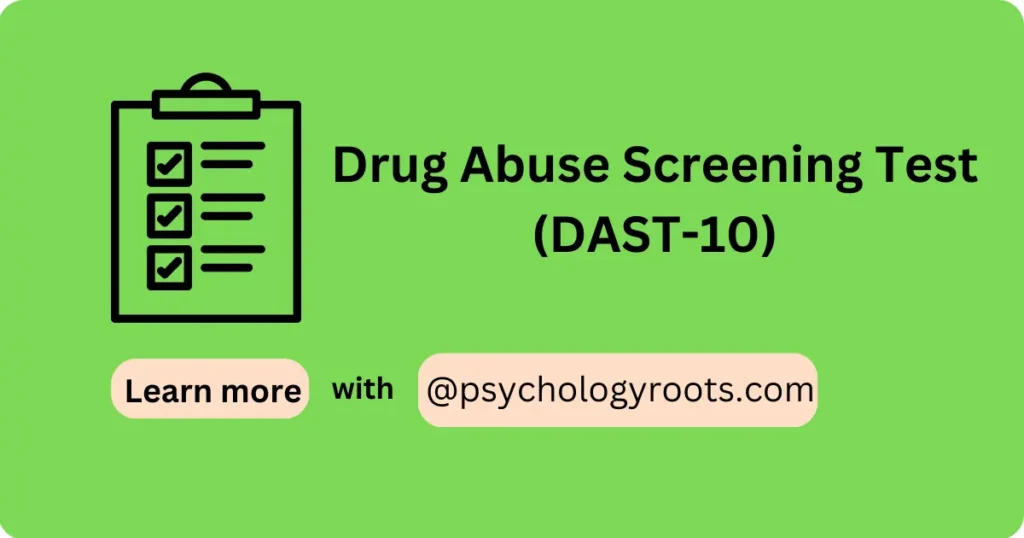Table of Contents
Drug Abuse Screening Test (DAST-10, 20, 28)
Here in this post, we are sharing the “Drug Abuse Screening Test (DAST-10)”. You can read psychometric and Author information. We have thousands of Scales and questionnaires in our collection (See Scales and Questionnaires). You can demand us any scale and questionnaires related to psychology through our community, and we will provide you with a short time. Keep visiting Psychology Roots.
About Scale Name
Scale Name
Drug Abuse Screening Test (DAST-10, 20, 28)
Author Details
Harvey A. Skinner
Translation Availability
Not Sure

Background/Description
The Drug Abuse Screening Test (DAST-10) is a 10-item self-report screening tool that is used to assess drug use in the past 12 months. It was developed by Harvey A. Skinner, PhD, in 1982 as a brief, self-report screening tool for drug abuse. It is a shortened version of the original 28-item DAST, which was developed in 1979.
The DAST-10 asks questions about the following areas:
- Drug use in the past 12 months
- Problems related to drug use
- Withdrawal symptoms
- Legal problems related to drug use
- Financial problems related to drug use
- Interpersonal problems related to drug use
The DAST-10 is scored by giving 1 point for each “yes” answer, except for question 3, which is scored 1 point for a “no” answer. The total score can range from 0 to 10.
A score of 0 indicates no evidence of drug abuse problems. A score of 1 to 3 suggests possible drug abuse problems. A score of 4 or more indicates a high likelihood of drug abuse problems.
The DAST-10 has been shown to be a reliable and valid screening tool for drug abuse. It has been used in a variety of settings, including clinical, research, and forensic settings.
The DAST-10 is not a diagnostic tool. It cannot be used to diagnose drug abuse or dependence. However, it can be a helpful tool for identifying individuals who may be at risk for drug abuse or dependence.
If you are concerned about your drug use, or if you think someone you know may be struggling with drug abuse, the DAST-10 can be a helpful tool for getting help. You can take the DAST-10 online or by downloading a copy from the Addiction Research Foundation website.
If you have a high score on the DAST-10, it is important to seek professional help. There are many resources available to help people with drug abuse problems, including treatment programs, support groups, and counseling.
Here are some of the limitations of the DAST-10:
- It is a self-report tool, which means that it relies on the honesty and accuracy of the individual taking the test.
- It does not assess the severity of drug abuse problems.
- It cannot be used to diagnose drug abuse or dependence.
Administration, Scoring and Interpretation
Here are the steps on how to administer the DAST-10:
- Read the instructions carefully.
- Answer each question honestly and to the best of your knowledge.
- If you have any questions about the questions, ask the clinician or administrator.
- Once you have answered all of the questions, score your test.
Reliability and Validity
The Drug Abuse Screening Test (DAST-10) is a reliable and valid screening tool for drug abuse.
Reliability refers to the consistency of the test. The DAST-10 has good internal consistency, meaning that the items on the test are measuring the same thing. It also has good test-retest reliability, meaning that people who take the test multiple times will get similar scores.
Validity refers to the accuracy of the test. The DAST-10 has good validity, meaning that it accurately identifies people who are at risk for drug abuse. It has been shown to have a high sensitivity, meaning that it is good at identifying people who have drug abuse problems. It also has a high specificity, meaning that it is good at identifying people who do not have drug abuse problems.
Available Versions
10-Items
28-Items
20-Items
Reference
Skinner, H. A. (1982). The Drug Abuse Screening Test. Addictive Behaviors, 7(4), 363–371. https://doi.org/10.1016/0306-4603(82)90005-3
Important Link
Scale File:
Frequently Asked Questions
What is the purpose of the DAST-10?
To screen for drug abuse in the past 12 months.
How is the DAST-10 scored?
Give yourself 1 point for each “yes” answer, except for question 3.
What is a high score on the DAST-10?
4 or more points.
What is the DAST-10 not?
A diagnostic tool.
Who can administer the DAST-10?
A clinician or self-administered.
How long does it take to take the DAST-10?
Less than 8 minutes.
Disclaimer
Please note that Psychology Roots does not have the right to grant permission for the use of any psychological scales or assessments listed on its website. To use any scale or assessment, you must obtain permission directly from the author or translator of the tool. Psychology Roots provides information about various tools and their administration procedures, but it is your responsibility to obtain proper permissions before using any scale or assessment. If you need further information about an author’s contact details, please submit a query to the Psychology Roots team.
Help Us Improve This Article
Have you discovered an inaccuracy? We put out great effort to give accurate and scientifically trustworthy information to our readers. Please notify us if you discover any typographical or grammatical errors.
Make a comment. We acknowledge and appreciate your efforts.
If you have any scale or any material related to psychology kindly share it with us at psychologyroots@gmail.com. We help others on behalf of you.